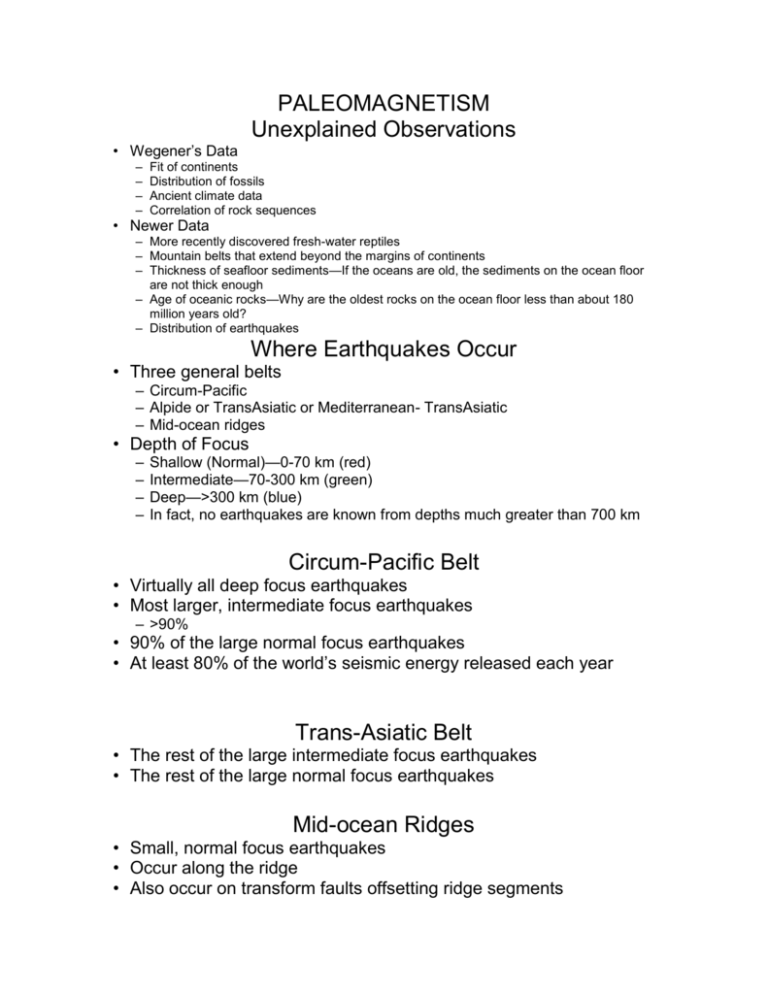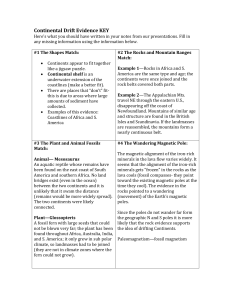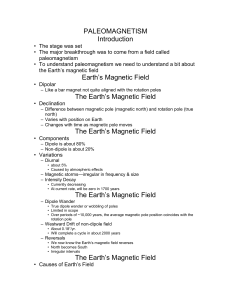PALEOMAGNETISM
advertisement

PALEOMAGNETISM Unexplained Observations • Wegener’s Data – – – – Fit of continents Distribution of fossils Ancient climate data Correlation of rock sequences • Newer Data – More recently discovered fresh-water reptiles – Mountain belts that extend beyond the margins of continents – Thickness of seafloor sediments—If the oceans are old, the sediments on the ocean floor are not thick enough – Age of oceanic rocks—Why are the oldest rocks on the ocean floor less than about 180 million years old? – Distribution of earthquakes Where Earthquakes Occur • Three general belts – Circum-Pacific – Alpide or TransAsiatic or Mediterranean- TransAsiatic – Mid-ocean ridges • Depth of Focus – – – – Shallow (Normal)—0-70 km (red) Intermediate—70-300 km (green) Deep—>300 km (blue) In fact, no earthquakes are known from depths much greater than 700 km Circum-Pacific Belt • Virtually all deep focus earthquakes • Most larger, intermediate focus earthquakes – >90% • 90% of the large normal focus earthquakes • At least 80% of the world’s seismic energy released each year Trans-Asiatic Belt • The rest of the large intermediate focus earthquakes • The rest of the large normal focus earthquakes Mid-ocean Ridges • Small, normal focus earthquakes • Occur along the ridge • Also occur on transform faults offsetting ridge segments Vertical distribution • Most earthquakes are shallow (normal focus) • In places in the ocean Hugo Benioff noted a pattern of increasing focal depth Conclusions • Earthquake foci get deeper under volcanic island arcs • Earthquake foci also get deeper under continents where trenches are adjacent to continents • Volcanoes are present at all of these sites • There must be a connection among ocean trenches, earthquakes of increasing focal depth, and volcanism Introduction • The stage was set • The major breakthrough was to come from a field called paleomagnetism • To understand paleomagnetism we need to understand a bit about the Earth’s magnetic field Earth’s Magnetic Field • Dipolar – Like a bar magnet not quite aligned with the rotation poles The Earth’s Magnetic Field • Declination – Difference between magnetic pole (magnetic north) and rotation pole (true north) – Varies with position on Earth – Changes with time as magnetic pole moves The Earth’s Magnetic Field • Components – Dipole is about 80% – Non-dipole is about 20% • Variations – Diurnal • about 5% • Caused by atmospheric effects – Magnetic storms—irregular in frequency & size – Intensity Decay • Currently decreasing • At current rate, will be zero in 1700 years The Earth’s Magnetic Field – Dipole Wander • True dipole wander or wobbling of poles • Limited in scope • Over periods of ~10,000 years, the average magnetic pole position coincides with the rotation pole – Westward Drift of non-dipole field • About 0.18°/yr. • Will complete a cycle in about 2000 years – Reversals • We now know the Earth’s magnetic field reverses • North becomes South • Irregular intervals The Earth’s Magnetic Field • Causes of Earth’s Field – – – – We really don’t know Must be internal Can not be a permanent magnet Self-exciting dynamo • • • • • Convection currents in the outer core Moving conductor in a magnetic field Generates electrical current Electrical current produces a magnetic field Sum of all convection cells produces Earth’s field How Rock’s Become Magnetized • Rocks become magnetized parallel to the Earth’s magnetic field at a particular time and place • Rocks that acquire magnetization quickly (like lava flows) record instantaneous pole positions • Intrusions and sedimentary rocks acquire a magnetization much more slowly, averaging out short term polar movements • Although the magnetic pole moves, when its position is averaged over periods on the order of 10,000 years, the average position of the magnetic pole coincides with the rotation pole • This means that paleomagnetic latitude is the same as geographic latitude How Rocks Become Magnetized • Thermal Remanent Magnetization – Due to cooling – Magnetic minerals acquire a magnetization parallel to the Earth’s magnetic field when they cool below the Curie Temperature – Important in igneous rocks • Detrital Remanent Magnetization – Grains settle and become magnetized parallel to the Earth’s field – Important in sedimentary rocks • Chemical Remanent Magnetization – New minerals grow parallel to Earth’s magnetic field • Isothermal Remanent Magnetization— lightning strikes • Viscous Remanent Magnetization—just sitting around Paleomagnetic Results • Many rocks acquired their magnetization at a latitude different from their present latitude • Rocks of the same age from anywhere on a single continent generally agree • Either the poles were shifting or the continents were drifting – Hold continents fixed and move poles for several continents – If all paths are the same, the poles moved; otherwise, the continents moved Reversals • Some rocks came up reversely magnetized • Discovered that rocks of certain ages anywhere in the world were reversed • Concluded that the Earth’s magnetic field reverses Meanwhile….. • Oceanic Data – Since WWII magnetometers were towed routinely – Found a series of magnetic highs and lows • Correlated from traverse to traverse • Produced a series of “magnetic stripes” on the ocean floor Ocean-Floor Anomalies Vine and Matthews • Knew about magnetic stripes and reversals that had been found on land – Combined that information to conclude that highs and lows represented normally and reversely magnetized rock – Suggested new material generated at mid-ocean ridges – Moved, as if on a conveyor belt away from ridge – Replaced by new material – This became known as sea-floor spreading Recognition of Magnetic Stripes Magnetic Time Scale Seafloor Magnetic Anomalies Age of the Ocean Floor Historical Notes • Lawrence W. Morley and Andre Larochelle had been studying reversely magnetized rocks and aeromagnetic maps • Morley saw the map showing the stripes in August of 1961 – The map was published by Mason and Raff – Like the authors, Morley could not explain the stripes • In early 1963 he read Robert Dietz’s description of seafloor spreading • Morley says that the explanation for the stripes suddenly dawned on him and he wrote an article – Submitted it to Nature in February of 1963 – It was not published because of a a lack of space – It also did not have a lot of data to support the conclusion Historical Notes • Morley then submitted his paper to the Journal of Geophysical Research in April of 1963 – While awaiting reviews, Morley presented his ideas at two meetings (one in June and one in August) – It was rejected, with the comment, “His idea is an interesting one—I suppose—but it seems most appropriate over martinis, say, [rather] than in the Journal of Geophysical Research” – Morley planned to submit the paper to another journal • The September 7, 1963, issue of Nature contained the paper by Vine and Matthews – Vine & Matthews get all the credit – Morley gets to be a footnote • The paper by Vine and Matthews really marked the beginning of the general acceptance of the idea of plate tectonics






